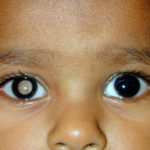Is removal of the eye always necessary?
Removal of the eye is only advised by the doctor when there is no way of saving it or when the tumor endangers the patient’s life. If your doctor suggests removing the eye, then the disease is very serious. The eye must be removed as soon as possible to stop the cancer from spreading. Keep in mind that if the cancer does spread past the eye, it may no longer be treatable.
Will surgical removal be the final treatment or will something else be required?
If the tumor has not spread much, then removing the eye is enough. However, if the tumor has spread out of the eye, then further treatment will be needed. This could include drug injections (chemotherapy) or high-energy rays (radiotherapy). The doctor will only be able to tell after the eye is removed.
Is there any way of restoring vision after the eye is removed?
Unfortunately, no. However, we can fit you with an artificial eye. This will look like a normal eye, so your face should still have its normal appearance.
When can the artificial eye be fitted?
It is usually fitted after the wound has healed and the swelling has subsided. This takes about 6 weeks.
Will removing one eye affect the other eye?
Removing one eye will not affect the other eye. However, the other eye should be checked by an eye doctor to make sure it doesn’t develop a similar tumor. Because the patient will only have one eye, it is best to come for serial checkups to preserve the vision of this eye. If there is any visual problem or discomfort, then it can be treated well before vision is lost.
Can the tumor come back after treatment?
Yes. There is always a chance that the tumor will come back, regardless of how it was treated the first time. For this reason, all patients must come for regularly follow-ups.
Is there any danger to other family members?
Yes. Because these tumors are common in children and may be linked to genetic disorders, both parents and all siblings should have their eyes examined.
What does radiotherapy and chemotherapy involve?
In radiotherapy, high energy rays are applied to specific areas to destroy tumor cells. In chemotherapy, specific medicines that target tumor cells are injected into the blood. In both cases, the patient will have to stay in the hospital for 2-3 days. The patient must also come for follow-ups, as advised by the doctor. Several doses of radiotherapy or chemotherapy may be required.
Both radiotherapy and chemotherapy can have several side effects, like:
- Nausea
- Vomiting
- Weight loss
- Severe hair loss
- Mental health struggles (mainly depression)
During this time, patients may rely on family members for moral support. They will also need healthy, balanced meals to regain their strength. Having a child with cancer can be hard. But if you are a parent, always remember that even something as small as a smile or a positive attitude can really help your child.
My spouse and I are not related by blood. Why does my child have a tumor?
Most cases of inherited retinoblastoma tumors are linked to consanguinity, meaning that both parents are blood relatives. Either one or both parents might have a defective gene. If the child inherits this gene and expresses it, he or she may develop a retinoblastoma tumor.
Our other child has two good eyes. How will this child accept their new life with one eye?
Children adapt very quickly, especially if the adults around them behave as if everything is normal. Please understand that this diseased eye had to be removed before it harmed the child’s life. Do not let the child ever see you depressed about the loss of the eye. Do not speak of the child as being less than normal. Once the tumor is taken care of, there is no reason your child cannot lead a full, healthy life.
How frequently will we have to bring our child to an eye doctor for check-up?
He/she will need a check-up:
- Every 3 months until the age of 3 years
- Every 6 months until the age of 6 years
- Every year from ages 6-15 years
Your doctor will schedule the next follow-up at each of your appointments. Be sure to follow their schedule closely.
Since our child has this tumor, can we have another child safely? What are the chances that this other child will also have retinoblastoma?
You will have to ask the doctor. If you want, it can be discussed as soon as possible. Your doctor might recommend charting your family tree and taking blood samples for genetic testing.



